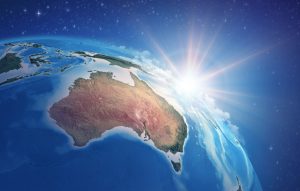As New York City gears up for the next United Nations General Assembly, there’s a new event on the schedule before the annual high-level debate. It’s the landmark Summit of the Future, a high-level event seeking to bring world leaders together and to realize the goal of Secretary General Antonio Guterres to implement “Our Common Agenda,” a vision for the future of global cooperation.
At the summit, nations across the globe are expected to adopt the Pact for the Future, which seeks to chart a pathway to achieving the Sustainable Development Goals (SDGs), which are significantly off track. Guterres is also seeking the support of member states to adopt the Global Digital Compact and the Declaration on Future Generations.
Mitigating and adapting to the effects of climate change is a key priority of the Pacific in the 2050 Strategy for the Blue Pacific Continent. On the current trajectory, global temperatures will exceed an average increase of 1.5 degrees Celsius before 2030 and will reach 2 degrees Celsius between 2041 and 2060 unless there are rapid, consequential, and sustained reductions in greenhouse gas emissions. That’s why Australia must implement a 1.5 C aligned emissions reduction target. Additionally, this will also show that the Australian government has been listening to its neighbors, which have repeatedly called for a phase out of fossil fuel use, projects, and exports.
Australia can productively contribute to the Summit and the upcoming United Nations General Assembly by pushing for additional, predictable, and higher quality climate investments across the Pacific and the wider region. This will help Australia advance the SDGs and “make the most of this critical milestone on the road to a more networked, effective and inclusive multilateralism for the twenty-first century,” as Guterres put it.
Australia’s development investment in the Pacific has increased steadily over the last decade, reflecting both the trajectory of geostrategic tensions in the region and an understanding that Australia’s development program is a key tool in forging closer relationships with the Pacific. In addition to Australia’s development program, the knowledge, organizational relationships and people-to-people links of Australian NGOs form a critical element of a whole-of-nation development approach in the Pacific. However, efforts do not go far enough to meet needs.
In May 2024, the Joint Standing Committee on Foreign Affairs, Defense, and Trade launched an inquiry into Australia’s response to the priorities of Pacific Island countries and the wider Pacific region. The Australian Council for International Development made a submission that outlined how Australia can strengthen its responses to climate change in the region. Our recommendations cover ways in which the Australian government can expand climate finance initiatives, strengthen partnerships, and promote mobility with dignity.
Funds to cover loss and damage must be paid in addition to mitigation and adaptation, because it is a separate area of need. Losses and damages occur when climate impacts cannot be averted (for example via mitigation), or minimized (via adaptation measures.) For many countries throughout the Pacific, addressing loss and damage requires distinct activities that are significantly different from mitigation and adaptation activities
There have been no contributions from Australia to the Loss and Damage Fund. Similar economies have made initial pledges of between $50 and $109 million, but no moves were made by Australia to contribute its fair share. That’s why ACFID has called for the Australian Government to contribute at least $100 million to the fund.
Australia has high historic emissions, high per capita emissions, and is the 13th largest economy in the world. Australia’s greenhouse gas emissions and economic size matter because they demonstrate that Australia has a historic and ongoing responsibility for climate change as per the “common but differentiated responsibilities and respective capabilities” enshrined in the United Nations Framework Convention on Climate Change.
The Australian government should also pay its $4 billion per annum fair share toward the global climate finance goal of $100 billion, with a significant portion going to Pacific Island countries based on needs. Crucially, this funding should be new and in addition to existing Official Development Assistance. Climate finance needs to represent new and additional resources, since its purpose is to help recipients deal with the additional burden of climate change. This means it should not displace “regular” development finance. Once agreed, the government must contribute its annual fair share of the New Collective Quantified Goal, which will be considered by states at COP29 in Azerbaijan later this year.
To support Pacific Island communities to safely stay on their sovereign, ancestral lands, the most effective action Australia can take is to provide its fair share of climate finance and commit to the phase out of fossil fuel uses and exports. However, the Australian government should also provide accessible pathways for the relocation of Pacific Island peoples who choose to move from their home when no longer able to live in safety and security due to the impacts of climate change.
This is best reflected with the Falepili Union Treaty between Australia and Tuvalu signed in 2023, where 280 special visas will be provided to Tuvaluans every year. Mobility with dignity for people affected by climate change must be supported, and the Australian government must ensure that current and future schemes are co-designed with Pacific communities.
The Pacific is facing an existential threat from climate change and Pacific Island countries have asked Australia repeatedly for help. Australia must contribute its fair share of climate finance to combat climate change, and support mobility initiatives.
The United Nations Summit of the Future provides critical opportunities for Australia to advocate in multilateral forums for increased climate action to support the priorities of Pacific Island states. Ahead of these critical multilateral forums and to advance a cohesive whole-of-nation approach to foreign policy, Australia’s climate investments must be additional, predictable, and higher quality.
































